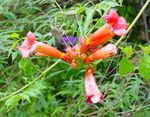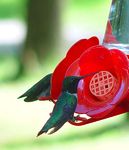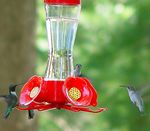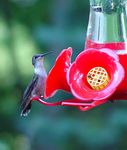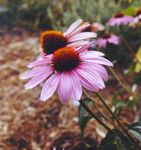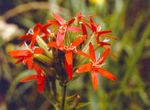Attracting Hummingbirds to Your Yard - Forestry and Natural Resources - Purdue Extension
←
→
Page content transcription
If your browser does not render page correctly, please read the page content below
FNR-249-W
Purdue University
Forestry and Natural Resources
Attracting Hummingbirds to Your Yard
Brian K. Miller and Brian J. MacGowan, Extension Wildlife Specialists
Department of Forestry and Natural Resources
Purdue University, West Lafayette, IN 47907
Hummingbirds are a popular attraction in any Ruby-throated hummingbirds have a few
backyard. The ruby-throated hummingbird is the simple habitat requirements that can be easily
only species of hummingbird that nests in the met in most neighborhoods and backyard
Hoosier state. These colorful visitors are migratory habitats. Hummingbirds need an ample supply
and arrive from their wintering grounds around of insects and nectar for food. Trees are
mid-April. Ruby-throated hummingbirds remain required for nesting, resting, and escape cover.
throughout the summer and can begin fall Landscapes that provide a mixture of mature
migration as early as late-July. Migrating ruby- hardwood forests with meadows, gardens,
throated hummingbirds can be observed in wetlands, shrub patches, and riparian areas
Indiana throughout the fall. It is possible to provide ideal habitat conditions for the ruby-
observe migrating hummingbirds at your feeder throated hummingbird. This mixture of habitat
from late-July through October and occasionally components describes many subdivisions and
later. In fact, during late autumn, rufous residential and rural areas throughout Indiana.
hummingbirds can be observed at feeders in Following a few of the tips described below can
Indiana. Some believe it is only a matter of time make your yard and neighborhood even more
that other western species such as the black- attractive for hummingbirds this summer.
chinned hummingbird are found in the state.
Food – Insects
Meeting the food requirements of the ruby-
throated hummingbird is the greatest secret
to attracting them. Despite common belief,
hummingbirds are not strictly nectar feeders.
Insects and other invertebrates are the primary
source of protein for adult hummingbirds and
their young. An adult female can consume up
to 2,000 insects per day. Small invertebrates
including mosquitoes, gnats, small bees, fruit
flies, spiders, caterpillars, aphids, and insect eggs
make up a portion of the hummingbird’s diet.
In natural settings, insects are attracted to
“weedy patches” that have a mixture of taller
grasses and forbs (non-woody, broadleaf plants).
Some wildflower garden designs provide the
required structure for ample insect populations,
Ruby-throated hummingbird. but naturalized areas containing a rich mixture
Purdue University Cooperative Extension Service • West Lafayette, Indiana
1FNR-249-W
of native forbs and grasses are excellent insect
habitats. Hummingbirds will forage for insects
in naturalized areas, but will also search rock
walls, bricks, cliffs, and other structures for insects,
often stealing small insects from spider webs.
If you live in rural areas or if your yard
is more secluded, simply tilling small areas
in the spring and leaving them fallow for 3-
5 years is one simple low cost approach to
developing these “weedy patches” for insects.
Leaving borders or selected areas of lawn un-
mowed is another cost effective way to provide
insect habitat for hummingbirds. However,
local ordinances and weed laws in some
neighborhoods may preclude such practices.
Check your local codes and ordinances prior to
initiating these practices.
For backyard landscaping, it is critical to Purple coneflower.
present these naturalized areas in a manner that
is pleasing to you and your neighbor. Integrate Food – Nectar
them with other landscape features so they don’t Hummingbirds have a very high metabolism.
stand out. Naturalized areas can be made more They can fly about 27 miles per hour and their
attractive and acceptable to neighbors by giving wings beat 53 times per second. It takes a lot
them some limits and defining their boundaries. of high-energy food to support this level of
Mow definite borders around them, pave a path activity. A hummingbird must eat its own body
through them, place a small segment of fence weight (about 3 grams) in nectar every day.
in front of them, or plant a few brightly colored Hummingbirds feed throughout the day at 5-
flowers around their borders. Applying a few minute to 1-hour intervals.
of these suggested practices will enhance the Nectar, an essential part of the
aesthetics of insect-producing areas in your hummingbird’s diet, is obtained from one of
backyard. two sources: flowers or nectar feeders. Flowers
Native wildflower gardens and flowering planted in your gardens and around your
trees and shrubs can provide abundant insects. yard provide a valuable source of nectar for
These areas can be attractive additions to any hummingbirds.
yard and provide the needed structure insects About 150 species of plants are pollinated by
require. The recommended practices above can hummingbirds rather than bees. Flower color
be used to demarcate definite boundaries around and structure in these species are less attractive
flower beds. Species such as purple coneflower to bees and other pollen feeding insects. Red is
(Echinacea purpurea) or bee balm (Monarda one color that bees do not see as well; therefore,
didyma) attract insects and can visually enhance many of the flowers that are pollinated by
any garden. Careful selection of additional hummingbirds tend to be red. Flowers designed
flower species (discussed below) will not only to favor hummingbirds usually don’t offer
help to attract insects for hummingbirds, but can perching platforms like many other flowers.
also provide nectar for both hummingbirds and These flowers often point downward and have
butterflies. long corolla tubes that exclude most insects.
2FNR-249-W
By selecting a mixture of flower and shrub splendens) are perennials that will add beauty to
species that have overlapping blooming seasons your gardens and will ensure that some nectar is
you will provide an available nectar source to being provided throughout the growing season.
hummingbirds visiting your yard throughout
the growing season. Extensive lists of plants for Annuals
hummingbirds are available in several of the Annual flower species most attractive
publications listed in the References section. to hummingbirds include: pinks (Dianthus
The following species are provided as a guide to spp.), zinnia (Zinnia elegans), snapdragons
getting started. (Antirrhinum spp.), Mexican sunflowers
(Tithonia spp.), scarlet sage (Salvia coccinea),
Trees flowering tobacco (Nicotania spp.), and
The Ohio buckeye (Aesculus glabra) is a jewelweed (Impatiens capensis).
native tree with flowers that provide nectar
for hummingbirds. Other nectar trees include Vines
horsechestnut (Aesculus hippocastanum) and Adding some native vines like trumpet
tulip poplar (Liriodendron tulipifera). creeper (Campis radicans), coral or trumpet
honeysuckle (Lonicera sempivirens), crossvine
Shrubs (Bignonia capreolata), or passionflower
Common shrub species providing nectar (Passiflora spp.) on trellises around garden
for hummingbirds include rhododendrons edges or yard borders can also provide a source
(Rhododendron spp.), deciduous azaleas of nectar for hummingbirds.
(Rhododendron spp.), rose mallow (Hibiscus
moscheustos), and pepperbush (Clethra spp.).
Perennials
Copper or red iris (Iris fulva), columbine
(Aquilegia canadensis), phlox (Phlox spp.),
beardtongue (Penstemon spp.), red morning
glory (Ipomoea coccinea), bee-balm, bergamot
(Monarda spp.), lilies (Lilium spp.), cardinal
flower (Lobelia cardinalis), fire-pink (Silene
virginica) , skullcap (Scutellaria spp.), foxglove
(Agalinas spp.), gayfeather (Liatris spp.), royal
catchfly (Silene regia), and scarlet sage (Salvia
Trumpet creeper.
Feeders
Nectar can also be made available by
providing artificial feeders. Feeders can provide
the nectar equivalent of 2,000-5,000 flowers.
Nectar feeders also provide a common focal
point in your yard where these colorful visitors
can be readily observed throughout the day.
Feeders provide a steady and valuable food
source in early spring when most flowers are
not yet in bloom. This food availability is
Royal catchfly.
3FNR-249-W
important in providing energy for hummingbirds Remember that hummingbirds are territorial.
that are preparing to reproduce. In addition, One dominant male can keep other males away
they can supplement natural sources of nectar from “his” feeder. As a result, you will attract
throughout the summer and fall when plants a larger number of hummingbirds by providing
in flower gardens are between flowering multiple feeders. Feeders should be spaced 10-15
stages. In the fall, feeders are important in feet apart. When you see more than four birds
helping hummingbirds gain weight for the long using a single feeder, or when you see a male
migration. Prior to migration, hummingbirds chasing off other males, add another feeder. As
will “balloon” from their normal 0.1-0.12 you keep adding feeders, you may be surprised
ounces to 0.19-0.22 ounces. This additional at the number of hummingbirds you attract.
.07 ounces will sustain them for their non-stop Hummingbirds need to rest between feedings.
trans-gulf migration of 18-22 hours. Locate your feeders near trees or perching
When selecting a nectar feeder for your yard, areas so they don’t have to move long distances
look for feeders that are easy to disassemble and between feeding and resting locations. Nearby
clean. Red feeders will more effectively attract perches also give them a place to wait their turn.
hummingbirds, but are less attractive to insects. Ripe fruit next to feeders increases its
The wasp and hornet guards (honey bees attractiveness and also attracts gnats and other
seldom, if ever, come to feeders) on the feeder insects eaten by the hummingbirds.
should be red (not yellow).
If you do not have a large number of
Selecting the proper site for your feeder hummingbirds that drain your feeders regularly,
is also an important consideration. Look for change the nectar every 3-4 days. This will
a shady area that is open enough to allow ensure that the nectar doesn’t ferment or become
hummingbirds to freely fly around the feeder. rancid, cloudy, or moldy. Feeders should
The shade cools the nectar and delays spoiling be cleaned every week or so with soap and
on hot summer days. water, rinsed with vinegar, and finally rinsed
thoroughly with water. This will help keep your
birds healthy. If ants become a problem on your
feeder, water filled ant guards can be installed to
keep ants out. Don’t use insecticides; they may
be harmful to hummingbirds.
Nectar solution for hummingbirds can be
Photo by Chip Morrison
made by simply mixing four parts water to
one part sugar. Boil the solution for 2 minutes
to slow fermentation. Do not microwave the
solution because it can cause a breakdown in
the sugar molecule, thus changing its nutritional
value. The mixture can be refrigerated until
needed to replenish feeders. Sugar water is a
perfectly acceptable if the feeder has a lot of
red on it. Don’t add honey, artificial sweeteners,
or food coloring to the mixture. These items
may pose some health problems for the
hummingbirds.
Make sure the insect guards are red (not yellow).
4FNR-249-W
Ruby-throated hummingbird nests are
usually located 10-20 feet above the ground in
deciduous trees on small horizontal branches.
They prefer isolated or undisturbed forest
areas for nesting. Hummingbirds will return
to the same nest each year and will rebuild if
Photo by Chip Morrison
necessary. Nests are made with down from
dandelion, thistle, and milkweed, and portions
of ferns, mosses, and young leaves. These
materials are attached to the limb with several
yards of sticky spider webs and droplets of
tree sap. The nest is camouflaged with lichens
usually found in the nest tree or surrounding
trees. Some of these nest materials can be
provided in your flower beds and surrounding
yard plantings.
Predators
Like most small birds, hummingbirds have
Leave the feeder up as long as birds are their share of predators including the praying
coming to it in the fall. This will not stop or mantis, snakes, blue jays, crows (nest predators)
delay their migration. Leaving feeders up and occasionally toads and frogs. The number
through October will make them available to one predator of hummingbirds is probably the
other migrant ruby-throated hummingbirds domestic cat. By providing food at a centralized
passing through even after “your” resident location such as flowerbeds and feeders, we
hummingbirds have left. By leaving a feeder often make it easy for cats to kill hummingbirds.
up later in the fall, you might attract another Cats should never be allowed to roam freely,
species of hummingbird that has been visiting as they kill many species of wildlife including
Indiana the past few years. Two of the birds, amphibians, small reptiles, and mammals.
Selasphorus species of hummingbirds (Rufous
and Allen’s) have been seen at various locations
in Indiana over the past several years.
Other Habitat Components
Ruby-throated hummingbirds are primarily Photo by Chip Morrison
a woodland species and require some woodland
component nearby to fulfill their habitat
requirements. Trees are used for resting and
for nesting cover. Landscapes that have some
patches of woodlands or mature hardwood trees
interspersed with yards, gardens and meadows
provides the additional food source of insects
and nectar hummingbirds require. Wetlands,
ponds, and streams, can enhance hummingbird
habitat due to the greater insect abundance in Add additional feeders if overcrowding becomes
some of these areas. an issue.
5References Additional Resources
Barnes T.G., 2000. Hummingbirds: An Williamson, S. 2002. A field guide to
Attractive Asset to Your Garden. University hummingbirds of North America. Houghton
of Kentucky, Cooperative Extension Service, Mifflin Co.
FOR-97. Cornell Lab of Ornithology http://birds.cornell.edu
www.ca.uky.edu/agc/pubs/for/for97/for97.htm
National Plants Database http://plants.usda.gov
Gardening for Hummingbirds and Butterflies.
Land Between the Lakes, Golden Pond,
Kentucky.
www.lbl.org
Sargent, R. 1999. Ruby-throated Hummingbird.
Stackpole Books, Mechanicsburg,
Pennsylvania.
USDA Natural Resource Conservation
Service. 1999. Ruby-throated Hummingbird
(Archilochus colubris). Wildlife Habitat
Management Fact Sheet, No.1. Wildlife
Habitat Management Institute, Madison,
Mississippi.
www.whmi.nrcs.usda.gov/technical/leaflet.htm
5/04
It is the policy of the Purdue University Cooperative Extension Service, David C. Petritz, Director,
that all persons shall have equal opportunity and access to the programs and facilities without regard to race, color, sex, religion, national
origin, age, marital status, parental status, sexual orientation, or disability.
Purdue University is an Affirmative Action institution.
This material may be available in alternative formats.
1-888-EXT-INFO
6http://www.agriculture.purdue.edu/fnr http://www.ces.purdue.edu/marketingYou can also read
